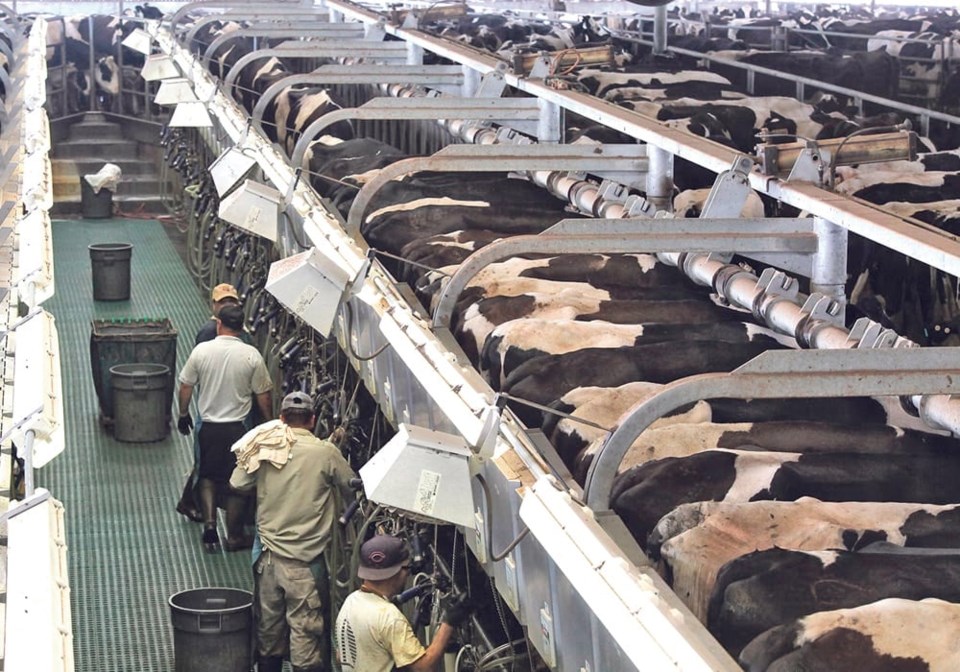The number in the New York Times headline from April 13 was hard to fathom: “About 18,000 Cattle Are Killed in Fire at Dairy Farm in Texas.”
The then-known facts — very few have been forthcoming since — were sparse. Around 7 p.m. on April 10, a fire roared through a dairy barn near Dimmit, Texas, “where thousands of dairy cows,” mostly Holsteins and Jerseys, had been “crowded together waiting to be milked, trapped in deadly confines,” noted USA Today.
The “deadly confines” were not, in any sense, confining. In fact, “If each animal stood three to four feet apart,” explained the newspaper, the 18,000 cows that died in the fire were “enough to cover 26 football fields.”
Imagine that hellscape: 26 roofed, wall-to-wall football fields ablaze with burning, bellowing Holstein and Jersey cows and there was nothing any man or beast could do but stand and watch it all burn.
While the massive scale of the Dimmitt fire may be unprecedented in U.S. agricultural history, as numerous news outlets reported at the time, mega-death events in today’s industrial scale livestock production are not.
For example, a “merciless” January 2016 blizzard in western Texas and eastern New Mexico killed an estimated 35,000 dairy cows, many buried in “snow drifts as high as 14 feet,” reported the Times.
But other livestock and poultry operations, mostly housed in barns engineered to both protect animals from the weather and improve their productivity, have suffered even greater losses. According to the Animal Welfare Institute, six million chickens, 151,800 pigs, 194,400 turkeys and 192,400 cattle died in fires on U.S. farms between January 2013 and January 2022.
However, noted Vox in its reporting on the Texas fire, “the true number is likely significantly higher … because not all states have the same reporting requirements and because farm animals are property with essentially no legal protection from suffering.”
Moreover, “fires at livestock and poultry production and storage properties are quite common,” it continued. The biggest reason, Vox noted in quoting the National Fire Protection Association, is that “animal farms don’t have the same fire codes and safety requirements as buildings designed for humans,” such as alarms and sprinklers.
That’s incomprehensible given the staggering costs in both loss of life and property of these catastrophic fires.
For example, Bob Cropp, a professor emeritus and former dairy marketing and policy extension specialist at the University of Wisconsin-Madison, estimates that the Texas fire cost its owners $27 to $36 million in cows alone. Property losses mean “you can probably double that” to come up with a “total rough estimate” of $55 million in losses.
But the “real question agriculture needs to ask itself,” Cropp said, isn’t how you prevent these massive, devastating fires, but “why would you even build a dairy operation this size? After a couple of thousand cows, there’s little to no more efficiency to be gained by going bigger.”
The Texas dairy, according to state agriculture commissioner Sid Miller, had one, very American market: the world.
“It is my understanding,” Miller told a Lubbock, Texas, media outlet April 20, “that the milk went to… make powdered milk, and most of that powdered milk is exported.”
Miller didn’t know it, but his explanation of why this industrialized dairy even existed characterizes one of the most important, and deadly, tenets of U.S. farm policy: we do almost anything — overproduce, subsidize, deplete natural resources, endanger animals, break federal employment laws and empty rural America —just for the chance to sell “more” overseas.
As such, the milk powder wasn’t the actual product the Texas CAFO (concentrated animal feeding operation) was selling abroad. The deal’s key ingredient to make the milk — that was then removed to make the milk powder — was the real export: the dirt cheap water from the ever-shrinking Ogallala Aquifer required by the dairy.
But few Americans ever talk about the actual costs of our costly livestock and poultry CAFO culture. Instead, we choose — ironically — to glorify its cheapness.
In the meantime, we burn irreplaceable parts of it to the ground.
Alan Guebert is an agricultural commentator from Illinois.




